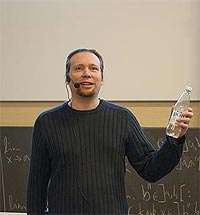Cover Song Identification Using Compression-based Distance Measures
M.Sc. Teppo E. Ahonen will defend his doctoral thesis Cover Song Identification Using Compression-based Distance Measures on Friday the 1st of April 2016 at 12 o'clock in the University of Helsinki Exactum Building, Auditorium CK112 (Gustaf Hällströminkatu 2b). His opponent is Academy Professor Petri Toiviainen (University of Jyväskylä) and custos Professor Esko Ukkonen (University of Helsinki). The defence will be held in Finnish.
Measuring similarity in music data is a problem with various potential applications. In recent years, the task known as cover song identification has gained widespread attention. In cover song identification, the purpose is to determine whether a piece of music is a different rendition of a previous version of the composition. The task is quite trivial for a human listener, but highly challenging for a computer.
This research approaches the problem from an information theoretic starting point. Assuming that cover versions share musical information with the original performance, we strive to measure the degree of this common information as the amount of computational resources needed to turn one version into another. Using a similarity measure known as normalized compression distance, we approximate the non-computable Kolmogorov complexity as the length of an object when compressed using a real-world data compression algorithm. If two pieces of music share musical information, we should be able to compress one using a model learned from the other.
In order to use compression-based similarity measuring, the meaningful musical information needs to be extracted from the raw audio signal data. The most commonly used representation for this task is known as chromagram: a sequence of real-valued vectors describing the temporal tonal content of the piece of music. Measuring the similarity between two chromagrams effectively with a data compression algorithm requires further processing to extract relevant features and find a more suitable discrete representation for them. Here, the challenge is to process the data without losing the distinguishing characteristics of the music.
In this research, we study the difficult nature of cover song identification and search for an effective compression-based system for the task. Harmonic and melodic features, different representations for them, commonly used data compression algorithms, and several other variables of the problem are addressed thoroughly. The research seeks to shed light on how different choices in the scheme attribute to the performance of the system. Additional attention is paid to combining different features, with several combination strategies studied. Extensive empirical evaluation of the identification system has been performed, using large sets of real-world music data.
Evaluations show that the compression-based similarity measuring performs relatively well but fails to achieve the accuracy of the existing solution that measures similarity by using common subsequences. The best compression-based results are obtained by a combination of distances based on two harmonic representations obtained from chromagrams using hidden Markov model chord estimation, and an octave-folded version of the extracted salient melody representation. The most distinct reason for the shortcoming of the compression performance is the scarce amount of data available for a single piece of music. This was partially overcome by internal data duplication. As a whole, the process is solid and provides a practical foundation for an information theoretic approach for cover song identification.
Availability of the dissertation
An electronic version of the doctoral dissertation is available on the e-thesis site of the University of Helsinki at http://urn.fi/URN:ISBN:978-951-51-2026-7.
Printed copies will be available on request from Teppo E. Ahonen: tel. 02941 51276 or teppo.ahonen@cs.helsinki.fi.

 The instruction at the Department of Computer Science continues in the limelight; this time in the form of personal recognition, as the student union at the University of Helsinki has awarded the Magister Bonus prize of 2011 to University Lecturer Matti Luukkainen. Matti was interviewed about teaching and studying by Ella Peltonen from TKO-äly immediately after the festivities.
The instruction at the Department of Computer Science continues in the limelight; this time in the form of personal recognition, as the student union at the University of Helsinki has awarded the Magister Bonus prize of 2011 to University Lecturer Matti Luukkainen. Matti was interviewed about teaching and studying by Ella Peltonen from TKO-äly immediately after the festivities. As announced by Nokia on Thursday 22 September 2011, Henry Tirri had been appointed Chief Technology Officer at Nokia and Executive Vice President of the Nokia Leadership Team, effective from that date. According to the bulletin, ‘As Chief Technology Officer, Tirri assumes responsibility for the CTO organization, charged with setting Nokia's technology agenda both now and in the future, and driving core innovation to enable business development opportunities.”
As announced by Nokia on Thursday 22 September 2011, Henry Tirri had been appointed Chief Technology Officer at Nokia and Executive Vice President of the Nokia Leadership Team, effective from that date. According to the bulletin, ‘As Chief Technology Officer, Tirri assumes responsibility for the CTO organization, charged with setting Nokia's technology agenda both now and in the future, and driving core innovation to enable business development opportunities.” The Linkki centre opened at the Helsinki University Department of Computer Science last Friday. The centre offers all kinds of fun activities like games programming, and an online programming course open to all upper-secondary students, starting at the beginning of next year.
The Linkki centre opened at the Helsinki University Department of Computer Science last Friday. The centre offers all kinds of fun activities like games programming, and an online programming course open to all upper-secondary students, starting at the beginning of next year.